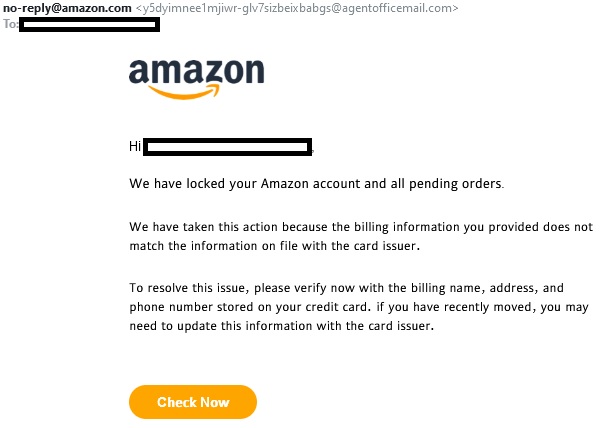
Before clicking any buttons and links from your email messages, you should first check the real sender and also the links behind buttons, images and other texts.
In this article we will cover an example of scam phishing attemp that targets Amazon customers.
Amazon.com, Inc. is an American multinational technology company which focuses on e-commerce, cloud computing, digital streaming, and artificial intelligence. It is one of the Big Five companies in the U.S. information technology industry, along with Google, Apple, Meta, and Microsoft.
The email title is called: “Account Locked” and the email body text contains:
𝖶𝖾 𝗁𝖺𝗏𝖾 𝗅𝗈𝖼𝗄𝖾𝖽 𝗒𝗈𝗎𝗋 𝖠𝗆𝖺𝗓𝗈𝗇 𝖺𝖼𝖼𝗈𝗎𝗇𝗍 𝖺𝗇𝖽 𝖺𝗅𝗅 𝗉𝖾𝗇𝖽𝗂𝗇𝗀 𝗈𝗋𝖽𝖾𝗋𝗌.
𝖶𝖾 𝗁𝖺𝗏𝖾 𝗍𝖺𝗄𝖾𝗇 𝗍𝗁𝗂𝗌 𝖺𝖼𝗍𝗂𝗈𝗇 𝖻𝖾𝖼𝖺𝗎𝗌𝖾 𝗍𝗁𝖾 𝖻𝗂𝗅𝗅𝗂𝗇𝗀 𝗂𝗇𝖿𝗈𝗋𝗆𝖺𝗍𝗂𝗈𝗇 𝗒𝗈𝗎 𝗉𝗋𝗈𝗏𝗂𝖽𝖾𝖽 𝖽𝗈𝖾𝗌 𝗇𝗈𝗍 𝗆𝖺𝗍𝖼𝗁 𝗍𝗁𝖾 𝗂𝗇𝖿𝗈𝗋𝗆𝖺𝗍𝗂𝗈𝗇 𝗈𝗇 𝖿𝗂𝗅𝖾 𝗐𝗂𝗍𝗁 𝗍𝗁𝖾 𝖼𝖺𝗋𝖽 𝗂𝗌𝗌𝗎𝖾𝗋.
𝖳𝗈 𝗋𝖾𝗌𝗈𝗅𝗏𝖾 𝗍𝗁𝗂𝗌 𝗂𝗌𝗌𝗎𝖾, 𝗉𝗅𝖾𝖺𝗌𝖾 𝗏𝖾𝗋𝗂𝖿𝗒 𝗇𝗈𝗐 𝗐𝗂𝗍𝗁 𝗍𝗁𝖾 𝖻𝗂𝗅𝗅𝗂𝗇𝗀 𝗇𝖺𝗆𝖾, 𝖺𝖽𝖽𝗋𝖾𝗌𝗌, 𝖺𝗇𝖽 𝗉𝗁𝗈𝗇𝖾 𝗇𝗎𝗆𝖻𝖾𝗋 𝗌𝗍𝗈𝗋𝖾𝖽 𝗈𝗇 𝗒𝗈𝗎𝗋 𝖼𝗋𝖾𝖽𝗂𝗍 𝖼𝖺𝗋𝖽. 𝗂𝖿 𝗒𝗈𝗎 𝗁𝖺𝗏𝖾 𝗋𝖾𝖼𝖾𝗇𝗍𝗅𝗒 𝗆𝗈𝗏𝖾𝖽, 𝗒𝗈𝗎 𝗆𝖺𝗒 𝗇𝖾𝖾𝖽 𝗍𝗈 𝗎𝗉𝖽𝖺𝗍𝖾 𝗍𝗁𝗂𝗌 𝗂𝗇𝖿𝗈𝗋𝗆𝖺𝗍𝗂𝗈𝗇 𝗐𝗂𝗍𝗁 𝗍𝗁𝖾 𝖼𝖺𝗋𝖽 𝗂𝗌𝗌𝗎𝖾𝗋.
Check Now
How you should know that this email is a scam?
1) The sender appears as: “[email protected]” but the real email address is visible: [email protected]
2) The “Check Now” button redirects to: https://me2.do/FGhni35c?=XcAJtyFHAUB2mlI , a spammy looking link that probably is an Amazon website clone, a login form clone that asks for your credentials.
Phishing is a type of social engineering where an attacker sends a fraudulent message designed to trick a human victim into revealing sensitive information to the attacker or to deploy malicious software on the victim’s infrastructure like ransomware.
Usenet convention defines spamming as excessive multiple posting, that is, the repeated posting of a message (or substantially similar messages).
PROTECTUMUS is a Website Security & Performance provider that combines AI and Machine Learning to detect attacks, protect against malware and recover in case of being hacked.
Protectumus provides a Free Website Security Check scanner that also verifies if an IP, a web, desktop or mobile app is marked as a spammer – Spam Health Check.

